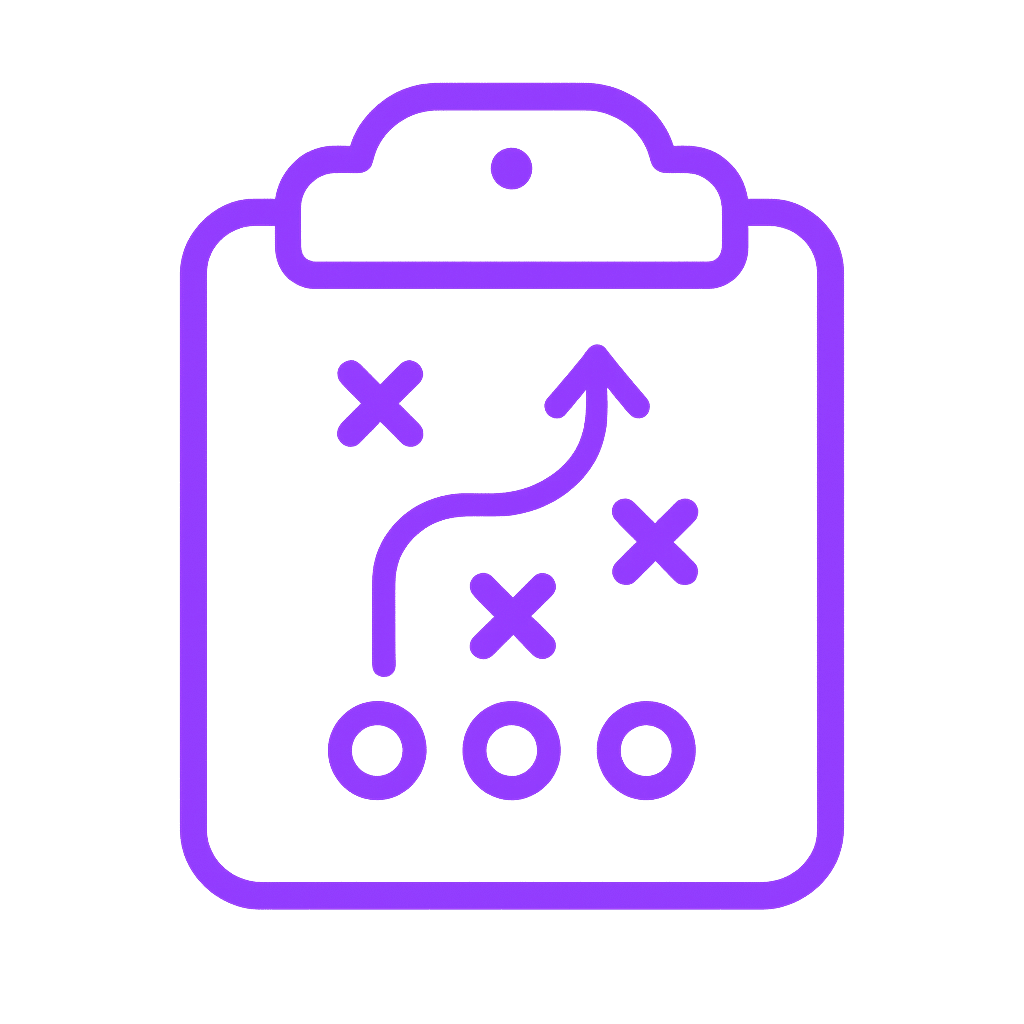
TL;DR
Don’t copy playbooks; sequence a few that fit your stage and biggest constraint. Use the five-question selector to choose, then run readiness checks (team, tools, timing, leadership). Execute with clear metrics, adjust when CAC rises, churn grows, or velocity stalls. Stack modules only after unlocking constraints; let AI draft, humans sequence.
Table of Contents
- What Most Teams Get Wrong About Playbooks
- The Real Role of Playbooks (and What They Are Not)
- The One-Playbook Trap: Why Startups Get Stuck
- A Better Model: Custom Playbooks Built from Modular Stacks
- The Full Playbook Landscape: 18 Proven Paths to Growth
- The 5-Question Playbook Selector: Start Where It Counts
- Making Sense of Your Results: Reading Your Playbook DNA
- Why AI Alone Won’t Hand You the Right Playbook
- Case Study: Designing a High-Impact Hybrid Playbook
- Real-World Playbook Combinations
- Strategic Maturity Means Knowing What Not to Run
- Metrics That Signal It’s Time to Pivot Your Playbook
- Conclusion: The Best Playbook Is the One You Build
- Frequently Asked Questions (FAQs)
What Most Teams Get Wrong About Playbooks

When a team hits a wall, the instinct is often to grab a playbook they’ve seen work for someone else. And sure, sometimes it works. But more often, the wheels spin. Not because the playbook itself is bad, but because it’s being run at the wrong moment.
In my experience, there are three main ways this goes wrong:
- The playbook is solving the wrong problem.
- The playbook doesn’t match the business’s stage or structure.
- The timing is completely off.
A playbook isn’t a silver bullet. It’s a deliberate sequence of actions designed to fix a very specific business constraint. A go-to-market playbook exists to get a product into the market, not to rescue a retention problem. A product-led growth playbook helps you drive adoption from the bottom up; it won’t suddenly make your enterprise sales motion faster. Run the wrong play, and you’re not just stuck; you might be digging a deeper hole.
Misalignment is another silent killer. I’ve seen companies pour effort into a partner enablement program before their product was even integration-ready. Or they launch a pricing overhaul when they still haven’t found product-market fit. It’s like renovating a house you haven’t even decided to buy.
But if I had to bet on the most common culprit, it’s mistiming. Founders copy a play because they saw it fuel another company’s growth, forgetting that what they’re seeing is the end of a sequence, not the messy groundwork that came before. That other team may have spent two years shoring up retention before ever touching acquisition.
The takeaway? You don’t win by collecting more playbooks. You win by sequencing the right ones in the right order, based on your reality, not someone else’s highlight reel.
The Real Role of Playbooks (and What They Are Not)
Somewhere along the way, “playbook” became a catch-all word. People use it to mean frameworks, checklists, brainstorming docs, and even slide decks with a few bullet points and a catchy title. But a real playbook is none of those things.
A genuine playbook is built for one purpose: execution. Not theory, not exploration, not endless debate. It’s the blueprint a team can pick up and run with when the conditions are right.
A good one answers five questions without hesitation:
- What exactly triggers it?
- What’s the objective?
- What outcomes define success?
- Which metrics will track progress?
- In what sequence will actions happen?
That sequencing is critical. A framework might help you think. A playbook tells you what to do, when to do it, and what “done” looks like.
The biggest mistakes happen when teams skip the “fit check” and run someone else’s playbook as-is. Maybe they copy a demand generation plan from a Series B SaaS company while they’re still trying to prove product-market fit. The result is burned resources, frustrated teams, and zero measurable lift. That’s not bad execution. That’s solving the wrong problem.
At its best, a playbook strips friction from one specific part of the business so momentum can build. At its worst, it becomes a shiny distraction that eats up time, money, and focus. The difference isn’t usually about how good the playbook is. It’s about whether it fits the moment.
Remember, a playbook isn’t a trophy. It’s just a tool. You don’t win by having it. You win by using it at the right time, for the right reason, in the right way.
When not to run Sales Acceleration?
If PMF is weak, activation leaks, or messaging is unproven, fix those first.
The One-Playbook Trap: Why Startups Get Stuck
The first time a playbook works, it feels like magic. You run the moves, the numbers go up, and you think, “We’ve cracked it.” That’s how a lot of companies fall into the “one-playbook” trap. They treat a winning approach as a lifelong commitment instead of a situational tool.
I’ve seen it happen again and again. A founder nails their first wave of customers with a scrappy go-to-market push. But churn is high, adoption is shallow, and the product’s real value hasn’t been nailed down. Instead of pausing to tighten product-market fit, the team just doubles their outreach. Now the original cracks turn into gaping holes.
The same story plays out in different disguises. Teams try to run a product-led growth play without a solid activation loop. They launch a new pricing strategy when sales enablement is barely functional. M&A integrations collapse because partner readiness was never in place.
The playbook is not flawed. The problem is that it’s answering the wrong question. What works for one company at one stage doesn’t automatically work for another. Success isn’t just about a catchy headline. It really comes down to your team’s skills, where you are in your business journey, how much capacity you have, and the kind of customers you’re targeting.
Growth is messy. It zigzags. And playbooks only work when they’re aimed at the real constraint, in the right order. Stick with one too long out of habit or FOMO, and you’re not moving forward; you’re just running in place, mistaking motion for progress.
A Better Model: Custom Playbooks Built from Modular Stacks
Here’s the truth: no single playbook covers every angle. Every business has its own mix of challenges, timing, and team dynamics. Trying to force a one-size-fits-all plan onto a messy, changing reality usually leads to missed details and frustration.
The best teams I know treat their playbooks like a toolbox. They grab only what they need, in the order that works for them. It’s like putting together a custom stack of solutions, each one solving a specific problem.
Take a B2B SaaS company pulling in $3 million in revenue. It might be wrestling with slow deal velocity and pressure on pricing. Its ideal stack could combine sales acceleration tools, customer onboarding improvements, and pricing experiments. Meanwhile, another company with the same revenue could be battling churn and weak upsells, and its playbook stack would look entirely different.
It’s not about piling on more strategies. It’s about clearing the path where the friction actually exists today. Modular playbooks let you adapt quickly without tearing everything down or waiting for a crisis.
Your playbook should reflect your goals, your team’s capacity, and the real bottlenecks you face. That mix is your playbook’s DNA. No ready-made template can build it without truly understanding your business first.
The Full Playbook Landscape: 18 Proven Paths to Growth
We’ve identified 18 core business playbooks across acquisition, retention, monetization, and scale-up stages. Only a fraction will fit your business at any given time. The framework above will help you narrow it down to the most relevant. For a high-level comparison of all 18 playbooks, click here.
The 5-Question Playbook Selector: Start Where It Counts
One of the fastest ways to waste a quarter is to pick a playbook just because it worked for someone else. The right move for you depends entirely on where your business stands today, not where a competitor stood two years ago. Context is everything: your stage, your biggest constraint, and the next milestone you must hit.
When I sit down with a leadership team, we start with five questions. Not to find the perfect playbook, because that’s a myth, but to pinpoint the one constraint that, if solved, makes everything else easier.
Note: If you are unfamiliar with any of the playbook names or abbreviations mentioned in this table, you can view the complete Playbook Glossary here for definitions and detailed explanations of all Playbooks.
Want to see the structure of your custom playbook? Try our Custom Interactive Playbook Builder
1. Which best describes your current annual recurring revenue (ARR) or revenue stage?
Sales Process Gaps
Every stage comes with its own landmines:
Stage | Likely Constraints | Useful Playbooks |
Pre-revenue | Validation, early traction, clarity on market need | Discovery, PMF |
Less than $1 million | Positioning, pipeline, conversion, initial demand gap | PMF, GTM, PLG*, Demand-Gen |
$1–$5 million | Scaling, retention, pricing | Sales Acceleration, Pricing & Monetization, Customer Success & Retention, Expansion & Upsell |
$5–$10 million | Market expansion, channel development, operational scaling | Scale-Up, Partner/Ecosystem, Localization |
More than $10 million | International expansion, partnerships, and operational maturity | Scale-Up, Partner/Ecosystem, Localization, M&A Integration, IPO Readiness, Digital Transformation, BOS** if market reframing |
*Product-Led Growth (PLG) is a go-to-market approach where the product itself drives user acquisition, conversion, and expansion.
**Blue Ocean Strategy (BOS) focuses on creating new market space and reducing direct competition, often through innovation or reframing existing products.
2. Do you have a repeatable product–market fit?
If the answer is no, stop chasing scale. Talk to more customers, refine activation, and get conversions humming. If yes, you’re ready to pull bigger commercial levers like Sales Acceleration or Monetization.
3. What’s your single top priority for the next year?
Priority | Matching Playbooks |
Launch a new product | GTM, Messaging, Onboarding; BOS or Category Creation if it is an innovative or reframed launch |
Accelerate customer acquisition/growth | PLG, Demand-Gen, Sales Acceleration |
Enter or reframe a new market/geography | Localization, Partner/Ecosystem, BOS, or Category Creation |
Optimize revenue or margins | Pricing & Monetization, Customer Success & Retention |
Prepare for exit / IPO | IPO Readiness, Scale-Up, M&A Readiness |
Fix stalled or declining growth | Turnaround/Revitalisation, Digital Transformation (if tech/process debt is material) |
4. Which expansion vectors are on your roadmap? (Select all that apply)
- New geography → Localization
- New product line → GTM Refresh, Category Creation, BOS if pursuing an uncontested segment
- Partnerships / channels → Partner/Ecosystem, Integration Readiness
- Inorganic expansion (acquisition) → M&A Integration (PMI)
- None of the above → Default to Q3 objective and Q5 constraint to select core playbooks
5. What’s the biggest current constraint?
Constraint | Playbooks That Help |
Low lead volume | Demand Gen, Messaging |
Sales delays | Sales Acceleration, Enablement |
Churn | Retention, CS, Onboarding |
Infrastructure scale | Tech Readiness, Ops Stack |
Capital pressure | Pricing, Monetization, Turnaround |
Market competition/differentiation | BOS, Category Creation, Positioning Refresh |
Once you’ve answered these, the choice usually becomes obvious. The right playbook is the one that tackles your most urgent constraint first, not the one with the shiniest success story.
It’s a discipline. And it’s why the best teams rarely chase ten priorities at once. They focus on the one thing that unlocks the rest, then move on. That’s how momentum builds, and that’s how you avoid the busywork trap.
Want to see the structure of your custom playbook? Try our Custom Interactive Playbook Builder
People Also Ask
1. What is playbook sequencing?
Pick and order 1–3 playbooks to remove today’s biggest constraint first.
2. PLG or GTM first?
GTM for (re)launch; PLG only with strong activation and self-serve readiness.
3. When to avoid Monetization?
ARR < $1M or PMF unproven, fix activation/retention first.
4. How many in parallel?
One to three; sequence by biggest unlock.
5. When to pivot?
When costs keep rising, deals slow, churn climbs, or leads stop converting, even after fixing the basics. Stop, diagnose, then switch or stack.
6. Partner prerequisites?
Integration readiness, shared ICP, enablement assets, and a defined co-sell process.
Making Sense of Your Results: Reading Your Playbook DNA
Answering the five questions won’t hand you a single, silver-bullet playbook. What you’ll see instead are patterns. Those patterns reveal the real story. The unique combination of priorities, bottlenecks, and opportunities that make up your Playbook DNA.
It’s not about finding the perfect recipe. It’s about building a menu that suits your appetite at this moment.
A few common examples:
- Revenue under $1M? Hold off on monetization experiments. You likely need a stronger product-market fit and sharper onboarding before thinking about margin lift.
- Pushing into new markets but fighting high churn? Nail retention before you pour fuel on the expansion fire.
- Aiming to go global but unclear on messaging? Fix positioning first; otherwise, you’ll just scale confusion into new time zones.
How to read your results
1. Spot the repeat signals.
If a theme like retention shows up in your revenue stage, your annual goal, and your primary constraint, that’s not a coincidence; it’s your starting point.
2. Tie top signals to specific, scoped playbooks.
Avoid vague ambitions like “improve marketing.” Instead, match the clearest and most urgent signal to a playbook with a well-defined scope.
3. Sequence your next two quarters.
Build in phases so each win sets up the next:
- Phase 1: Remove the main constraint.
- Phase 2: Layer in accelerators.
- Phase 3: Set the stage for the next leap, like funding, expansion, and new product lines.
Example: Turning raw answers into a stack
Category | User Input | Recommended Stack |
Revenue | $2M ARR | Scaling up |
PMF Clarity | Yes | Ready for expansion |
Priority | Increase conversion & ACV | Sales Acceleration, Pricing |
Expansion Vector | New product line | GTM Refresh, Category Messaging, BOS if targeting a new or uncontested segment |
Constraint | Deals moving slowly | Enablement, Sales Process, Qualification |
Suggested order:
- Sales Enablement
- Pricing Experiments
- GTM Refresh
- Expansion Messaging
Choosing the right playbook stack isn’t about chasing the biggest ambition in the room. It’s about eliminating the friction that’s holding you back. The mix of your answers defines your current shape. That shape is your playbook DNA, and once you see it clearly, the sequence of moves usually becomes obvious.
Why AI Alone Won’t Hand You the Right Playbook

Artificial intelligence can process inputs at remarkable speed. It can sort, summarize, and reshape your ideas in seconds. What it can’t grasp, at least for now, are the unique pressures, quirks, and constraints that shape your business.
Most AI models are trained on broad, averaged patterns. They can tell you what’s common, not necessarily what’s right for you. That’s the gap between generic advice and targeted strategy.
The limits of AI in playbook selection
A tool like ChatGPT can map out popular growth frameworks or explain the logic behind a sales acceleration model. What it can’t do is tell you whether your weak onboarding metrics stem from clunky activation flows or from value messaging that misses the mark. That distinction requires not just information but judgment, pattern recognition, and an understanding of your company’s internal reality.
When AI is the only decision-maker, you risk:
- Solving the wrong problem.
- Overestimating execution capacity because the model can’t read your team’s actual readiness.
- Ignoring cultural or leadership dynamics that affect adoption.
- Making calls on flawed assumptions if the inputs you give it are incomplete or misleading.
Where AI adds value and where it doesn’t
Task | Human Required? | AI Support Level |
Choosing a playbook based on context | Yes | Low |
Drafting internal rollout docs | No | High |
Summarizing playbook structure | No | High |
Assessing readiness or org fit | Yes | Low |
Updating checklists or timelines | No | High |
AI excels at speed and structure. It can draft the SOP, tidy up the deck, and pull together best-practice checklists in minutes. But deciding which playbook to run and when to shift gears is a human job. That decision demands you weigh timing, budget, capabilities, and the reality of the constraint.
The smarter model is the hybrid.
- Let AI handle the research, formatting, and documentation lift.
- Let human judgment define constraints, sequence priorities, and sanity-check feasibility.
- Use a platform like ImpelHub to merge both, giving you the velocity of AI with the discernment of experienced operators.
AI is a powerful lever. But like any lever, it only works when you know where to place the fulcrum. Context comes from people. The execution blueprint comes from both.
Case Study: Designing a High-Impact Hybrid Playbook
When TraceWrap, a logistics visibility startup, set out to accelerate growth, it avoided the trap of running a single ‘proven’ playbook in isolation. Instead, it built a modular stack, each module solving a specific constraint, sequenced to deliver compounding results.
Starting Point:
TraceWrap had strong early traction, but three clear bottlenecks:
- Slow pilot-to-paid conversions from unclear ROI messaging.
- Integration delays when connecting to customer systems.
- Underused LinkedIn presence for lead generation.
The Stack and Sequence:
- Quarter 1: Sales Acceleration module with an ROI Demonstration Framework to rebuild the pitch process around measurable loss-prevention metrics, shortening decision cycles.
- Quarter 2: Onboarding Optimization module with an API Integration Readiness checklist and standardized handoff process to cut onboarding delays.
- Quarter 3: Demand Generation module focused on LinkedIn Zero-Click Outreach, replacing broad cold outreach with targeted, ICP-specific engagement to drive inbound interest.
Projected Sequence of Impact:
Quarter | Focus | Goals/Targets |
Q1 | ROI-focused Sales Acceleration | +18% pilot-to-paid conversion rate |
Q2 | Onboarding Optimization | Reduce onboarding time from 45 to 25 days |
Q3 | LinkedIn Demand Generation | +32% qualified inbound leads |
Outcome:
By sequencing only the most relevant modules, TraceWrap avoided the one-playbook trap and positioned itself for sustained growth. Each improvement set up the next, creating momentum without overloading the team.
Real-World Playbook Combinations
In practice, few companies thrive by running a single playbook in isolation. Growth challenges are rarely that clean. The real skill lies in stacking only the modules that match your stage, capacity, and objectives and doing it without overwhelming your team.
Below are snapshots of real scenarios where layered playbooks solved complex constraints without creating operational chaos.
Example 1 – SaaS company at $600K ARR
- Challenge: Low free-trial conversion paired with weak activation among paying users.
- Stack:
- PMF Validation – pull early indicators from trial behavior
- GTM Refinement – sharpen positioning and tighten ICP definition
- Monetization Tests – run light pricing experiments
- Outcome: Activation rate jumped 24% in two quarters.
Example 2 – Fintech at $10M ARR expanding into EMEA
- Challenge: Global launch into markets where brand awareness was near zero.
- Stack:
- Scale-Up Playbook – structure the team and align capital deployment
- Localization – adapt language, meet compliance requirements, tailor regional messaging
- Partner Strategy – build joint go-to-market motions with integration partners
- Outcome: Closed first EMEA deals in under 90 days, with partners driving credibility and distribution.
Example 3 – DTC brand at $4M ARR facing high churn
- Challenge: Declining repeat purchase rate and shrinking LTV.
- Stack:
- Retention Playbook – redesign post-purchase flows and service touchpoints
- Turnaround Playbook – refresh brand clarity, introduce referral incentives
- Customer Success Enhancements – boost email engagement and improve helpdesk SLAs
- Outcome: Churn dropped by 31% within three months.
One playbook alone would have fallen short, addressing only fragments of the problem. The wins came from sequencing complementary modules, tackling root causes in the right order, and resisting the temptation to run every possible play at once.
Strategic Maturity Means Knowing What Not to Run

One of the most underrated skills in leadership is restraint. Many teams overestimate what they can execute and underestimate the cost of running a playbook before they’re truly ready.
A great strategy isn’t just about what to run; it’s about knowing which playbooks to delay or skip entirely. Trying out a new playbook isn’t easy. It asks for time and effort from everyone. If you jump in without the right setup, even a great plan can just fizzle out.
Execution Readiness Filters
Before committing, run your playbook through these four checkpoints:
Checkpoint | Question to Ask |
Team Capacity | Do we have the right roles in place to execute fully? |
Tooling | Can we track both progress and outcomes without guesswork? |
Timing | Can we focus on this initiative without competing priorities derailing it? |
Leadership Support | Will decision-makers actively support and unblock the effort? |
When teams pull the trigger too early:
- Launching Sales Acceleration before cleaning and structuring the CRM.
- Starting a Retention Program before understanding the real churn drivers.
- Rolling out a Partner Playbook before the product supports integrations.
These failures didn’t come from bad playbooks. They came from good playbooks run in the wrong conditions.
Strategic maturity isn’t about running the most advanced playbooks or checking every growth box. It’s about running the right ones at the right time, when the team is set up to win. Execution readiness is the difference between a playbook that accelerates growth and one that burns cycles without moving the needle.
Metrics That Signal It’s Time to Pivot Your Playbook
Playbooks aren’t something you set once and forget. Each one tackles a specific problem. When the problem it was built for is solved, or a new one emerges, its value drops fast.
But habit is strong. Too many teams keep running the same plays, blind to the fact that the game has moved on. That means wasted effort and missed chances. Want to know the key? It’s recognizing exactly when the data says it’s time to change course.
Common shift indicators and what they mean
Metric Behavior | Likely Diagnosis | Suggested Response |
Customer Acquisition Cost (CAC) is steadily rising | Lead quality is dropping or pricing is misaligned | Add Pricing experiments or Demand Generation modules |
Churn increasing post-onboarding | Messaging lacks clarity or gaps in post-sale support | Deploy Retention and Customer Success playbooks |
Sales velocity is slowing | Objections aren’t being handled effectively, or the qualification is weak | Introduce the Sales Enablement module |
High Net Revenue Retention (NRR) but sluggish growth | Expansion efforts work, but top-of-funnel engagement is stalling | Shift focus to Awareness campaigns or Product-Led Growth (PLG) |
MQL-to-deal conversion plateauing | GTM messaging is stale or misaligned with the ideal customer profile (ICP) | Refresh ICP and Messaging strategies |
Knowing when to stack, switch, or stop
- Stack: Add new modules when your core playbook still works, but fresh constraints emerge.
- Switch: Change course when your main business constraint shifts and your current playbook no longer addresses it.
- Stop: Pause or drop playbooks when progress plateaus and your team is spread too thin across too many initiatives.
The best teams don’t pile on playbooks just for the sake of it. They run fewer, but run them better. The secret is knowing which plays matter most and when to play them.
Conclusion: The Best Playbook Is the One You Build
Failure rarely comes from a lack of effort. More often, it’s the result of applying effort in the wrong order, chasing shiny new playbooks without a clear sense of timing or fit.
This guide isn’t about picking the latest trendy playbook off the shelf. It’s about helping you craft a focused, deliberate stack. One that fits your business stage. One that works within your constraints. One that matches your execution capacity.
Key takeaways to hold onto:
- A playbook is not a strategy. It’s a targeted response to a specific business constraint.
- Make sure the decision to run a playbook is grounded in clear, measurable signals.
- Timing is as critical as the playbook’s content. When you act can be the difference between breakthrough and burnout.
- Stacking multiple playbooks only works if each solves a distinct problem. Piling on without clarity wastes resources.
- Human judgment is indispensable for assessing readiness, sequencing initiatives, and navigating trade-offs.
Before you launch, run this quick readiness check:
Question | Yes | No |
Have we identified the most urgent constraint? |
|
|
Do we have the team and roles needed to run this well? |
|
|
Can we track and measure progress with reliable data? |
|
|
Have we reviewed and aligned competing priorities? |
|
|
Is this solution tackling a real pain point, or are we following a shiny trend? |
|
|
If you answered “No” to more than one question, pause. Take a step back. Reassess your needs. Talk to someone who can help translate your answers into a practical, working playbook.
At ImpelHub, we guide companies through this exact process, combining diagnostic insight, modular playbooks, and hands-on expertise to sequence the right stack for your unique reality.
You don’t need another template. You need a plan that fits your business. The best playbook isn’t borrowed. It’s built.
Frequently Asked Questions (FAQs)
What’s a playbook?
An executable blueprint targeting one constraint: clear trigger, objective, success metrics, owners, and sequenced steps.
How do we choose?
Use the five-question selector; prioritize stage and constraint. If no PMF: PMF+Onboarding. If ARR<1M: avoid Monetization. Churn: Retention.
How many at once?
Run one to three maximum; sequence by biggest constraint to fastest unlock; avoid parallel initiatives without capacity.
When not to run PLG?
Skip PLG when activation is weak, onboarding is high-touch, enterprise complexity blocks self-serve, or data instrumentation is immature.
GTM vs Sales Acceleration?
GTM handles launch, positioning, ICP, channels. Sales Acceleration shortens cycles and improves win rate after PMF through enablement and process.
Are we ready?
Score Team, Tooling, Timing, Leadership. If two or fewer strong, delay; close gaps, assign owners, instrument metrics first.
When to pivot?
Pivot when CAC rises, sales velocity drops, churn increases, or MQL-to-deal conversion stalls; address root constraint, then stack.



